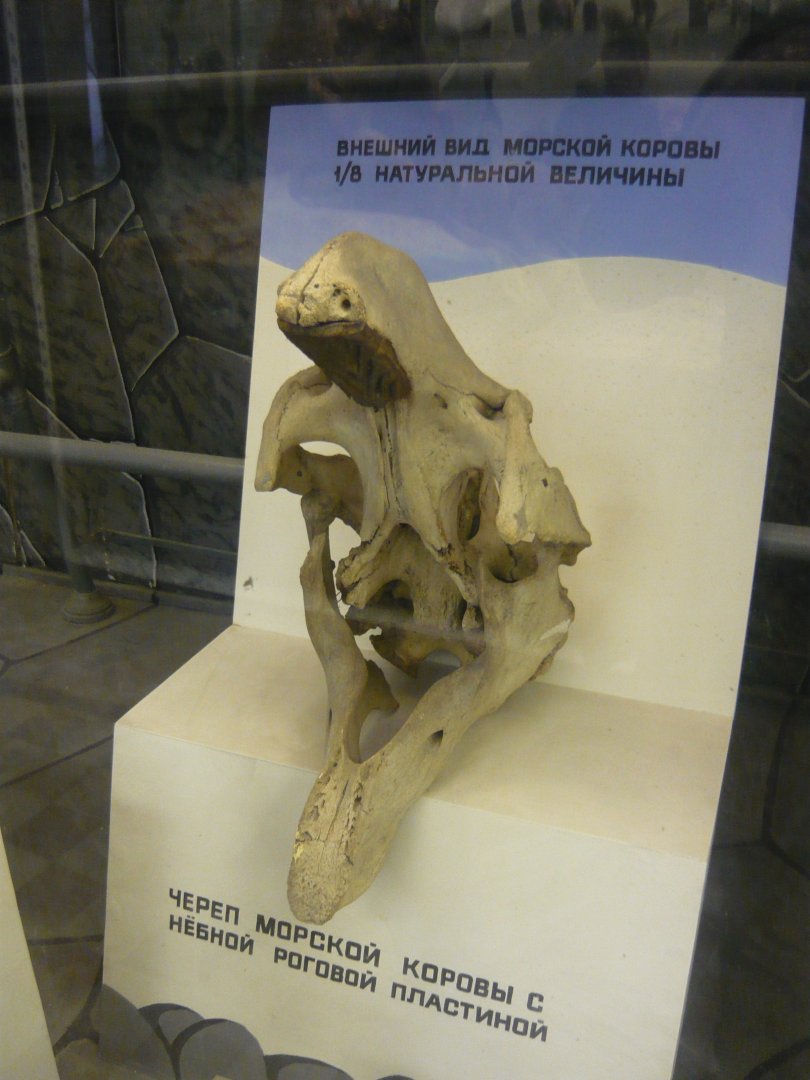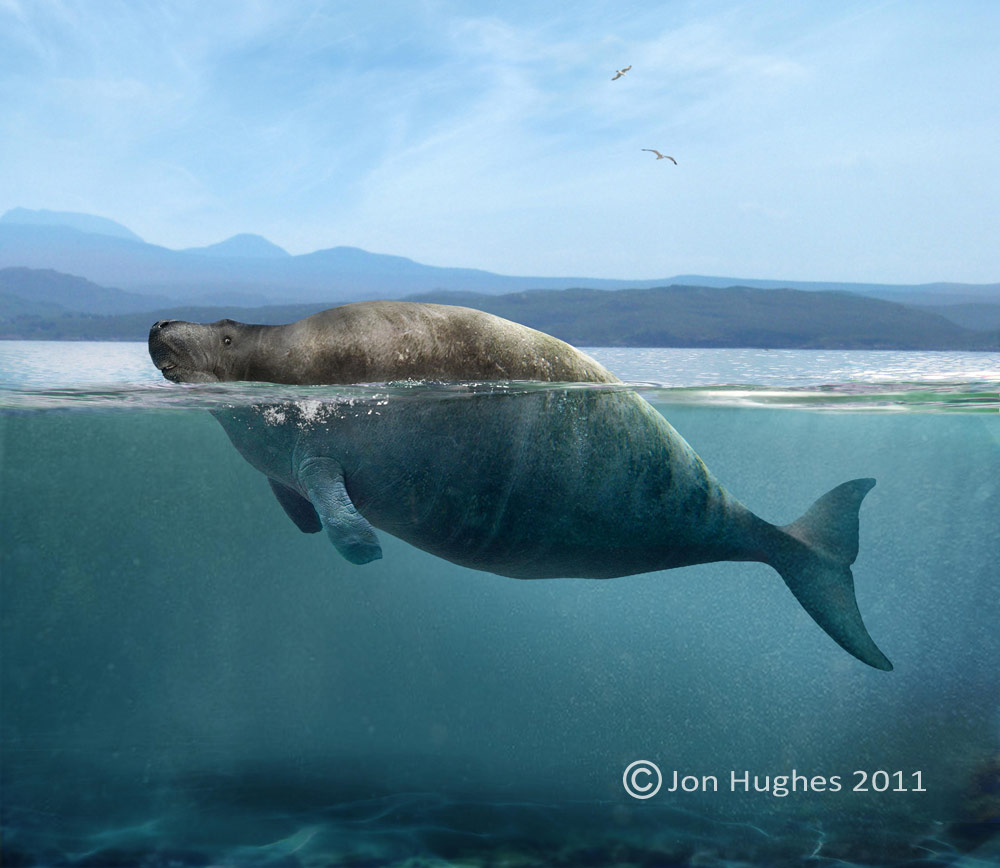Post by Infinity Blade on May 9, 2015 22:29:25 GMT 5
Steller's Sea Cow-Hydrodamalis gigas

An illustration of Hydrodamalis gigas being hunted by humans (Homo sapiens). Artist unknown.
Temporal range: Holocene (until 1768 CE).
Scientific classification:
Domain: Eukaryota
(unranked): Unikonta
(unranked): Opisthokonta
(unranked): Holozoa
(unranked): Filozoa
Kingdom: Animalia
Subkingdom: Eumetazoa
(unranked): Bilateria
Superphylum: Deuterostomia
Phylum: Chordata
Infraphylum: Gnathostomata
Clade: Eugnathostomata
Clade: Teleostomi
Superclass: Tetrapoda
Clade: Reptiliomorpha
Clade: Amniota
Clade: Synapsida
Clade: Eupelycosauria
Clade: Sphenacodontia
Clade: Sphenacodontoidea
Order: Therapsida
Clade: Theriodontia
Clade: Eutheriodonta
Suborder: Cynodontia
Clade: Epicynodontia
Infraorder: Eucynodontia
Parvorder: Probainognathia
Superfamily: Chiniquodontoidea
Clade: Prozostrodontia
Clade: Mammaliaformes
Class: Mammalia
Legion: Cladotheria
Sublegion: Zatheria
Infralegion: Tribosphenida
Subclass: Theria
Clade: Eutheria
Infraclass: Placentalia
Magnorder: Atlantogenata
Superorder: Afrotheria
Clade: Paenungulata
Clade: Tethytheria
Order: Sirenia
Family: Dugongidae
Subfamily: †Hydrodamalinae
Genus: †Hydrodamalis
Species: †H. gigas
Steller's sea cow (Hydrodamalis gigas) was the largest sirenian that ever lived.
Description:
H. gigas was ~9 meters in length[1] and weighed ~8-10 metric tons.[2] Its forelimbs were used for swimming, locomotion in more shallow areas, etc. The animal's skin was thick and tough to the point of being described by Georg Wilhelm Steller as "more like unto the bark of an ancient oak than unto the skin of an animal". Furthermore, it was also described as "black, mangy, wrinkled, rough, hard, and tough; it is void of hairs, and almost impervious to an ax or to the point of a hook".[3] Steller's sea cow could not swim fast nor could it submerge.[4]
Feeding:
The jaws had no teeth; instead there were bristles that pulled out seaweed and held food. Two pieces of bone were used to chew.[3] Kelp was a food source for the sea cow.[4]
Extinction:
<1,500 Steller's sea cows were left when Steller described them in 1741.[5] These particular sea cows lived in the Commander Islands. Human hunting probably caused it to become extinct elsewhere in previous times; its survival in the Commander Islands is implied to be due to the place being uninhabited by humans. Aboriginal hunters likely not only hunted sea cows, but also overexploited sea otters that fed on urchins: without otters keeping urchin numbers in check, increasing urchin numbers would have deprived sea cows of food.[6] When news of the Steller's sea cow spread in 1742, it was hunted once again. Apparently, "new hunting expeditions were formed almost every year".[7] Likewise, sea otters were also hunted extensively, increasing the population of sea urchins and thus decreasing the abundance of kelp, which formed the staple diet of Steller's sea cow.[6] An assessment of whether or not hunting by itself could have caused the extinction of Steller's sea cow was made; judging from how quickly the animal went extinct on Bering Island it was indeed more than enough to cause its extinction, let alone with the aid of other factors.[8] Overall, the Steller's sea cow's extinction was a result of human hunting and was facilitated by the reduced abundance of food supply (which was also-albeit indirectly-anthropogenic). Steller's sea cow was extinct by 1768, 27 years after it was first described.[8]

Mounted skeleton of H. gigas.
References:
[1] Helene Marsh, Thomas J. O'Shea, & John. E. Reynolds (2012). Ecology and Conservation of the Sirenia: Dugongs and Manatees.
[2] "The Weight of the Steller Sea Cow" (Scheffer, 1972).
[3] Georg Wilhelm Steller (1751). De Bestiis Marinis, or, The Beasts of the Sea.
[4] Richard Ellis (2004). No Turning Back: The Life and Death of Animal Species.
[5] Caryn Self-Sullivan (2007). "Evolution of the Sirenia".
[6] "Competition, Predation, and the Evolution and Extinction of Steller's Sea Cow, Hydrodamalis gigas" (Anderson, 1995).
[7] www.sirenian.org/stellers.html
[8] www.iucnredlist.org/details/10303/0

An illustration of Hydrodamalis gigas being hunted by humans (Homo sapiens). Artist unknown.
Temporal range: Holocene (until 1768 CE).
Scientific classification:
Domain: Eukaryota
(unranked): Unikonta
(unranked): Opisthokonta
(unranked): Holozoa
(unranked): Filozoa
Kingdom: Animalia
Subkingdom: Eumetazoa
(unranked): Bilateria
Superphylum: Deuterostomia
Phylum: Chordata
Infraphylum: Gnathostomata
Clade: Eugnathostomata
Clade: Teleostomi
Superclass: Tetrapoda
Clade: Reptiliomorpha
Clade: Amniota
Clade: Synapsida
Clade: Eupelycosauria
Clade: Sphenacodontia
Clade: Sphenacodontoidea
Order: Therapsida
Clade: Theriodontia
Clade: Eutheriodonta
Suborder: Cynodontia
Clade: Epicynodontia
Infraorder: Eucynodontia
Parvorder: Probainognathia
Superfamily: Chiniquodontoidea
Clade: Prozostrodontia
Clade: Mammaliaformes
Class: Mammalia
Legion: Cladotheria
Sublegion: Zatheria
Infralegion: Tribosphenida
Subclass: Theria
Clade: Eutheria
Infraclass: Placentalia
Magnorder: Atlantogenata
Superorder: Afrotheria
Clade: Paenungulata
Clade: Tethytheria
Order: Sirenia
Family: Dugongidae
Subfamily: †Hydrodamalinae
Genus: †Hydrodamalis
Species: †H. gigas
Steller's sea cow (Hydrodamalis gigas) was the largest sirenian that ever lived.
Description:
H. gigas was ~9 meters in length[1] and weighed ~8-10 metric tons.[2] Its forelimbs were used for swimming, locomotion in more shallow areas, etc. The animal's skin was thick and tough to the point of being described by Georg Wilhelm Steller as "more like unto the bark of an ancient oak than unto the skin of an animal". Furthermore, it was also described as "black, mangy, wrinkled, rough, hard, and tough; it is void of hairs, and almost impervious to an ax or to the point of a hook".[3] Steller's sea cow could not swim fast nor could it submerge.[4]
Feeding:
The jaws had no teeth; instead there were bristles that pulled out seaweed and held food. Two pieces of bone were used to chew.[3] Kelp was a food source for the sea cow.[4]
Extinction:
<1,500 Steller's sea cows were left when Steller described them in 1741.[5] These particular sea cows lived in the Commander Islands. Human hunting probably caused it to become extinct elsewhere in previous times; its survival in the Commander Islands is implied to be due to the place being uninhabited by humans. Aboriginal hunters likely not only hunted sea cows, but also overexploited sea otters that fed on urchins: without otters keeping urchin numbers in check, increasing urchin numbers would have deprived sea cows of food.[6] When news of the Steller's sea cow spread in 1742, it was hunted once again. Apparently, "new hunting expeditions were formed almost every year".[7] Likewise, sea otters were also hunted extensively, increasing the population of sea urchins and thus decreasing the abundance of kelp, which formed the staple diet of Steller's sea cow.[6] An assessment of whether or not hunting by itself could have caused the extinction of Steller's sea cow was made; judging from how quickly the animal went extinct on Bering Island it was indeed more than enough to cause its extinction, let alone with the aid of other factors.[8] Overall, the Steller's sea cow's extinction was a result of human hunting and was facilitated by the reduced abundance of food supply (which was also-albeit indirectly-anthropogenic). Steller's sea cow was extinct by 1768, 27 years after it was first described.[8]
Mounted skeleton of H. gigas.
References:
[1] Helene Marsh, Thomas J. O'Shea, & John. E. Reynolds (2012). Ecology and Conservation of the Sirenia: Dugongs and Manatees.
[2] "The Weight of the Steller Sea Cow" (Scheffer, 1972).
[3] Georg Wilhelm Steller (1751). De Bestiis Marinis, or, The Beasts of the Sea.
[4] Richard Ellis (2004). No Turning Back: The Life and Death of Animal Species.
[5] Caryn Self-Sullivan (2007). "Evolution of the Sirenia".
[6] "Competition, Predation, and the Evolution and Extinction of Steller's Sea Cow, Hydrodamalis gigas" (Anderson, 1995).
[7] www.sirenian.org/stellers.html
[8] www.iucnredlist.org/details/10303/0









